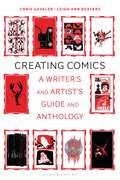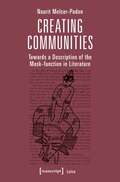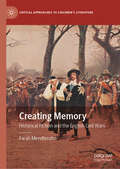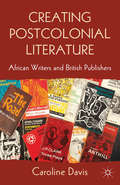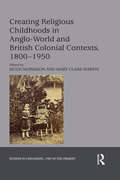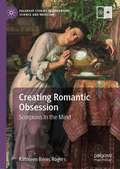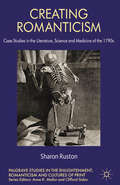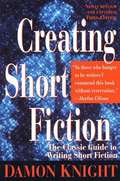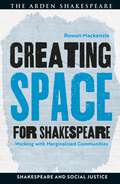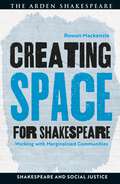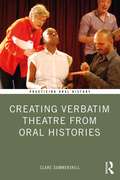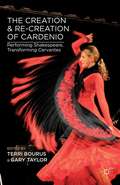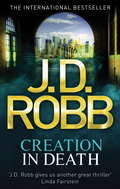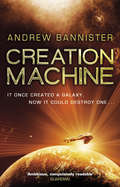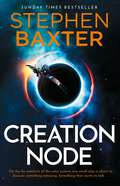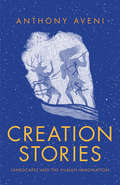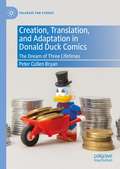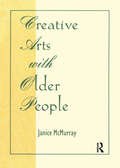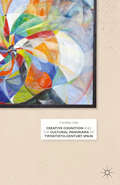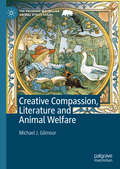- Table View
- List View
Creating Comics: A Writer's and Artist's Guide and Anthology (Bloomsbury Writers’ Guides and Anthologies)
by Chris Gavaler Leigh Ann BeaversFor creative writers and artists, comics provide unique opportunities for expression – but unique challenges, too. Creating Comics brings together in one volume an authoritative guide to the creative process, with practical drawing exercises throughout and an anthology of comics demonstrating the eclectic possibilities of the form. Creating Comic covers: · Using images to conceive and develop characters and stories· The complete range of possible relationships between two images· The step-by-step structure of visual narratives· How to approach each page like a unique canvas· Combining words and images to create new meanings Fully integrated with the main guide, the anthology section includes work by creators including: Lynda Barry, Alison Bechdel, Jaime Hernandez, Marjane Satrapi, Adrian Tomine, and many others.
Creating Communities: Towards a Description of the Mask-function in Literature (Lettre)
by Nourit Melcer-PadonHow does historical reality interrelate with fiction? And how much are readers themselves involved in the workings of fictional literature? With innovative interpretations of various well-known texts, Nourit Melcer-Padon introduces the use of literary masks and illustrates literature's engagement of its readers' ethical judgement. She promotes a new perception of literary theory and of connections between thinkers such as Iser, Castoriadis, Sartre, Jung and Neumann. The book offers a unique view on the role of the community in post-existentialist modern cultural reality by emphasizing the importance of ritual practices in literature as a cultural manifestation.
Creating Communities: Towards a Description of the Mask-function in Literature (Lettre)
by Nourit Melcer-PadonHow does historical reality interrelate with fiction? And how much are readers themselves involved in the workings of fictional literature? With innovative interpretations of various well-known texts, Nourit Melcer-Padon introduces the use of literary masks and illustrates literature's engagement of its readers' ethical judgement. She promotes a new perception of literary theory and of connections between thinkers such as Iser, Castoriadis, Sartre, Jung and Neumann. The book offers a unique view on the role of the community in post-existentialist modern cultural reality by emphasizing the importance of ritual practices in literature as a cultural manifestation.
Creating Memory: Historical Fiction and the English Civil Wars (Critical Approaches to Children's Literature)
by Farah MendlesohnThis book considers the English Civil Wars and the civil wars in Scotland and Ireland through the lens of historical fiction—primarily fiction for the young. The text argues that the English Civil War lies at the heart of English and Irish political identities and considers how these identities have been shaped over the past three centuries in part by the children’s literature that has influenced the popular memory of the English Civil War. Examining nearly two hundred works of historical fiction, Farah Mendlesohn reveals the delicate interplay between fiction and history.
Creating Postcolonial Literature: African Writers and British Publishers
by C. DavisUsing case studies, this book explores the publishing of African literature, addressing the construction of literary value, relationships between African writers and British publishers, and importance of the African market. It analyses the historical, political and economic conditions framing the emergence of postcolonial literature.
Creating Realities: Business as a Motif in American Fiction, 1865-1929 (American Culture Studies #25)
by Erhan SimsekBusiness is woven into the very fabric of American life, yet rarely surfaces in the nation's literary history. Even in novels about business, it proves an elusive motif that fails to mirror actual business organizations. This book argues that literary representations of business remain ineffable because business serves potential aesthetic functions, subtly yet meaningfully impacting readers. Exploring the complex representation of business in realist, naturalist and modernist works, Erhan Simsek reveals these functions by analyzing how the motif intertwines with social developments, literary movements and author biographies. He thus illuminates the motif itself while highlighting the utility of a focus on the changing functions of literature.
Creating Religious Childhoods in Anglo-World and British Colonial Contexts, 1800-1950 (Studies in Childhood, 1700 to the Present)
by Hugh Morrison Mary Clare MartinDrawing on examples from British world expressions of Christianity, this collection further greater understanding of religion as a critical element of modern children’s and young people’s history. It builds on emerging scholarship that challenges the view that religion had a solely negative impact on nineteenth- and twentieth-century children, or that ‘secularization’ is the only lens to apply to childhood and religion. Putting forth the argument that religion was an abiding influence among British world children throughout the nineteenth and most of the twentieth centuries, this volume places ‘religion’ at the center of analysis and discussion. At the same time, it positions the religious factor within a broader social and cultural framework. The essays focus on the historical contexts in which religion was formative for children in various ‘British’ settings denoted as ‘Anglo’ or ‘colonial’ during the nineteenth and early- to mid-twentieth centuries. These contexts include mission fields, churches, families, Sunday schools, camps, schools and youth movements. Together they are treated as ‘sites’ in which religion contributed to identity formation, albeit in different ways relating to such factors as gender, race, disability and denomination. The contributors develop this subject for childhoods that were experienced largely, but not exclusively, outside the ‘metropole’, in a diversity of geographical settings. By extending the geographic range, even within the British world, it provides a more rounded perspective on children’s global engagement with religion.
Creating Religious Childhoods in Anglo-World and British Colonial Contexts, 1800-1950 (Studies in Childhood, 1700 to the Present)
by Hugh Morrison Mary Clare MartinDrawing on examples from British world expressions of Christianity, this collection further greater understanding of religion as a critical element of modern children’s and young people’s history. It builds on emerging scholarship that challenges the view that religion had a solely negative impact on nineteenth- and twentieth-century children, or that ‘secularization’ is the only lens to apply to childhood and religion. Putting forth the argument that religion was an abiding influence among British world children throughout the nineteenth and most of the twentieth centuries, this volume places ‘religion’ at the center of analysis and discussion. At the same time, it positions the religious factor within a broader social and cultural framework. The essays focus on the historical contexts in which religion was formative for children in various ‘British’ settings denoted as ‘Anglo’ or ‘colonial’ during the nineteenth and early- to mid-twentieth centuries. These contexts include mission fields, churches, families, Sunday schools, camps, schools and youth movements. Together they are treated as ‘sites’ in which religion contributed to identity formation, albeit in different ways relating to such factors as gender, race, disability and denomination. The contributors develop this subject for childhoods that were experienced largely, but not exclusively, outside the ‘metropole’, in a diversity of geographical settings. By extending the geographic range, even within the British world, it provides a more rounded perspective on children’s global engagement with religion.
Creating Romantic Obsession: Scorpions in the Mind (Palgrave Studies in Literature, Science and Medicine)
by Kathleen Béres RogersMost of us have, at one time, been obsessed with something, but how did obsession become a mental illness? This book examines literary, medical, and philosophical texts to argue that what we call obsession became a disease in the Romantic era and reflects the era’s anxieties. Using a number of literary texts, some well-known (like Mary Shelley’s 1818 Frankenstein and Edgar Allan Poe’s 1843 “The Tell Tale Heart”) and some not (like Charlotte Dacre’s 1811 The Passions and Charles Brockden Brown’s 1787 Edgar Huntly), the book looks at “vigilia”, an overly intense curiosity, “intellectual monomania”, an obsession with study, “nymphomania” and “erotomania”, gendered forms of desire, “revolutiana”, an obsession with sublime violence and military service, and “ideality,” an obsession with an idea. The coda argues that traces of these Romantic constructs can be seen in popular accounts of obsession today.
Creating Romanticism: Case Studies in the Literature, Science and Medicine of the 1790s (Palgrave Studies in the Enlightenment, Romanticism and Cultures of Print)
by S. RustonThis book argues that the term 'Romanticism' should be more culturally-inclusive, recognizing the importance of scientific and medical ideas that helped shape some of the key concepts of the period, such as natural rights, the creative imagination and the sublime.
Creating Short Fiction (Third Edition) (PDF)
by Damon KnightDistilled from decades of teaching and practice, this book offers clear and direct advice on structure, pacing, dialogue, getting ideas, working with the unconscious, and more. Newly revised and expanded for this Third Edition, Creating Short Fiction is a popular and widely trusted guide to writing short stories of originality, durability, and quality. Celebrated short-story author and writing instructor Knight also includes many examples and exercises that have been effective in classrooms and workshops everywhere.
Creating Space for Shakespeare: Working with Marginalized Communities (Shakespeare and Social Justice)
by Rowan MackenzieApplied Shakespeare is attracting growing interest from practitioners and academics alike, all keen to understand the ways in which performing his works can offer opportunities for reflection, transformation, dialogue regarding social justice, and challenging of perceived limitations. This book adds a new dimension to the field by taking an interdisciplinary approach to topics which have traditionally been studied individually, examining the communication opportunities Shakespeare's work can offer for a range of marginalized people. It draws on a diverse range of projects from across the globe, many of which the author has facilitated or been directly involved with, including those with incarcerated people, people with mental health issues, learning disabilities and who have experienced homelessness. As this book evidences, Shakespeare can be used to alter the spatial constraints of people who feel imprisoned, whether literally or metaphorically, enabling them to speak and to be heard in ways which may previously have been elusive or unattainable. The book examines the use of trauma-informed principles to explore the ways in which consistency, longevity, trust and collaboration enable the development of resilience, positive autonomy and communication skills. It explores this phenomenon of creating space for people to find their own way of expressing themselves in a way that mainstream society can understand, whilst also challenging society to 'see better' and to hear better. This is not a process of social homogenisation but of encouraging positive interactions and removing the stigma of marginalization.
Creating Space for Shakespeare: Working with Marginalized Communities (Shakespeare and Social Justice)
by Rowan MackenzieApplied Shakespeare is attracting growing interest from practitioners and academics alike, all keen to understand the ways in which performing his works can offer opportunities for reflection, transformation, dialogue regarding social justice, and challenging of perceived limitations. This book adds a new dimension to the field by taking an interdisciplinary approach to topics which have traditionally been studied individually, examining the communication opportunities Shakespeare's work can offer for a range of marginalized people. It draws on a diverse range of projects from across the globe, many of which the author has facilitated or been directly involved with, including those with incarcerated people, people with mental health issues, learning disabilities and who have experienced homelessness. As this book evidences, Shakespeare can be used to alter the spatial constraints of people who feel imprisoned, whether literally or metaphorically, enabling them to speak and to be heard in ways which may previously have been elusive or unattainable. The book examines the use of trauma-informed principles to explore the ways in which consistency, longevity, trust and collaboration enable the development of resilience, positive autonomy and communication skills. It explores this phenomenon of creating space for people to find their own way of expressing themselves in a way that mainstream society can understand, whilst also challenging society to 'see better' and to hear better. This is not a process of social homogenisation but of encouraging positive interactions and removing the stigma of marginalization.
Creating Verbatim Theatre from Oral Histories (Practicing Oral History)
by Clare SummerskillOffering a roadmap for practicing verbatim theatre (plays created from oral histories), this book outlines theatre processes through the lens of oral history and draws upon oral history scholarship to bring best practices from that discipline to theatre practitioners. This book opens with an overview of oral history and verbatim theatre, considering the ways in which existing oral history debates can inform verbatim theatre processes and highlights necessary ethical considerations within each field, which are especially prevalent when working with narrators from marginalised communities. It provides a step-by-step guide to creating plays from interviews and contains practical guidance for determining the scope of a theatre project: identifying narrators and conducting interviews, developing a script from excerpts of interview transcripts and outlining a variety of ways to create verbatim theatre productions. By bringing together this explicit discussion of oral history in relationship to theatre based on personal testimonies, the reader gains insight into each field and the close relationship between the two. Supported by international case studies that cover a wide range of working methods and productions, including The Laramie Project and Parramatta Girls, this is the perfect guide for oral historians producing dramatic representations of the material they have sourced through interviews, and for writers creating professional theatre productions, community projects or student plays.
Creating Verbatim Theatre from Oral Histories (Practicing Oral History)
by Clare SummerskillOffering a roadmap for practicing verbatim theatre (plays created from oral histories), this book outlines theatre processes through the lens of oral history and draws upon oral history scholarship to bring best practices from that discipline to theatre practitioners. This book opens with an overview of oral history and verbatim theatre, considering the ways in which existing oral history debates can inform verbatim theatre processes and highlights necessary ethical considerations within each field, which are especially prevalent when working with narrators from marginalised communities. It provides a step-by-step guide to creating plays from interviews and contains practical guidance for determining the scope of a theatre project: identifying narrators and conducting interviews, developing a script from excerpts of interview transcripts and outlining a variety of ways to create verbatim theatre productions. By bringing together this explicit discussion of oral history in relationship to theatre based on personal testimonies, the reader gains insight into each field and the close relationship between the two. Supported by international case studies that cover a wide range of working methods and productions, including The Laramie Project and Parramatta Girls, this is the perfect guide for oral historians producing dramatic representations of the material they have sourced through interviews, and for writers creating professional theatre productions, community projects or student plays.
The Creation and Re-Creation of Cardenio: Performing Shakespeare, Transforming Cervantes
by Terri Bourus and Gary TaylorDid Shakespeare really join John Fletcher to write Cardenio, a lost play based on Don Quixote? With an emphasis on the importance of theatrical experiment, a script and photos from Gary Taylor's recent production, and essays by respected early modern scholars, this book will make a definitive statement about the collaborative nature of Cardenio.
Creation In Death: 25 (In Death #25)
by J. D. RobbFor him, death was a vocation. He was a maestro in the art of death. The keeper of time. The bringer of destiny.Lieutenant Eve Dallas is as tough as New York cops come. But on discovering the tortured body of a young woman, Eve is catapulted back to nine years ago, when a serial killer plagued the city and taunted her mercilessly. Putting rings on their fingers and carving their bodies, he was named The Groom. And this time he is working up to his greatest challenge yet: abducting a woman who will test him like never before and become his most gratifying victim yet - Eve.'A witty, dark, page-turning tale' Jonathan KellermanBook Twenty-Five in the New York Times number one bestselling series
Creation Machine: (The Spin Trilogy 1)
by Andrew BannisterIt is the aftermath of civil war in the vast pageant of planets and stars known as The Spin. Three years since he crushed the rebellion, Viklun Haas, industrialist and leader of the Hegemony, is eliminating all remnants of the opposition. Starting with his own daughter.But Fleare Haas, fighter for Society Otherwise has had a long time to plan her next move. Sprung from her remote monastery prison and reuniting with a team of loyal friends, Fleare’s journey will take her across The Spin to the cluster of fallen planets known as the The Catastrophe Curve - and from exile, to the very frontiers of war.Meanwhile, in the brutal and despotic empire of The Fortunate, word is reaching viceroy Alameche of a most unusual piece of plunder from their latest invasion. For hundreds of millions of years, the bizarre planets and stars of The Spin itself have been the only testament to the god-like engineers that created it. Now, buried in the earth of a ruined planet, one of their machines has been found . . .
Creation Node
by Stephen BaxterIn the year 2255, of all the sentient beings in her universe, it was a woman named Salma, twenty years old, who was the first fully to see the object called Planet Nine. See with her own eyes, albeit moderated by her ship's instruments. If not to recognise what it was, not yet.Not that the object turned out to be a planet, or the 'ninth' of anything. Briefly thought to be a black hole, it suddenly changes, expands and sends a message. There is something waiting on its service. Something not quite human.As the ramifications of this event spread across the fracturing elements of humanity, it is clear that the small crew on the spot are at the centre of the most dramatic discovery in history. But theirs is not the only inexplicable event happening - impossibly, at exactly the same moment, a quasar appeared twenty-five thousand light years away, and now is heating up the solar system.If the enigma of the creation node is not solved quickly, there may be no one left to investigate it . . .
Creation Stories: Landscapes and the Human Imagination
by Anthony AveniAn accessible exploration of how diverse cultures have explained humanity’s origins through narratives about the natural environment Drawing from a vast array of creation myths—Babylonian, Greek, Aztec, Maya, Inca, Chinese, Hindu, Navajo, Polynesian, African, Norse, Inuit, and more—this short, illustrated book uncovers both the similarities and differences in our attempts to explain the universe. Anthony Aveni, an award-winning author and professor of astronomy and anthropology, examines the ways various cultures around the world have attempted to explain our origins, and what roles the natural environment plays in shaping these narratives. The book also celebrates the audacity of the human imagination. Whether the first humans emerged from a cave, as in the Inca myths, or from bamboo stems, as the Bantu people of Africa believed, or whether the universe is simply the result of Vishnu’s cyclical inhales and exhales, each of these fascinating stories reflects a deeper understanding of the culture it arose from as well as its place in the larger human narrative.
Creation, Translation, and Adaptation in Donald Duck Comics: The Dream of Three Lifetimes (Palgrave Fan Studies)
by Peter Cullen BryanThis book examines the scope and nature of Donald Duck and his family's popularity in Germany, in contrast to the diminished role they play in America. This is achieved through examination of the respective fan communities, business practices, and universality of the characters. This work locates and understands the aspects of translation and adaptation that inform the spread of culture that have as yet been underexplored in the context of comic books. It represents a large-scale attempt to incorporate adaptation and translation studies into comics studies, through a lens of fan studies (used to examine both the American and German fan communities, as well as the work of Don Rosa). This work builds on the efforts of other scholars, including Janet Wasko and Illaria Meloni, while expanding the historical understanding of what might be the world’s best-selling comics.Peter Cullen Bryan is Lecturer at Pennsylvania State University, USA. His areas of study include American Studies, Intercultural Communications, and 21st Century American culture, emphasizing comic art and fan communities. His research has appeared in the Journal of Fandom Studies, The Journal of American Culture, and Popular Culture Studies Journal. He serves on the boards of the Mid-Atlantic Popular Culture Association and the Popular Culture Association, as well as Secretary for the Intercultural Communication section of the International Communication Association.
Creative Arts With Older People
by Janice McmurrayWith this insightful and intelligent book, professionals can help institutionalized older adults express themselves creatively. One of only a few books on expressive arts for older people, this unique, new volume is ideal for professionals who provide art activities for residents in adult homes and retirement communities.Creative experience can facilitate the expression of ideas and feelings, increase sensory stimulation, improve self-esteem, and improve social relationships. Creative Arts With Older People provides time-tested suggestions to stimulate the creative process among older adults, resulting in numerous physical, psychological, and social benefits. The author, an artist and a social worker, describes dozens of activities that have proven effective in her many years of working with older people--painting, movement, poetry, sculpting, puppetry, dramatic expression, and more. She explains the goals and advantages of each activity, includes a list of materials needed, and details the step-by-step process for conducting each activity.Creative Arts With Older People is a practical and valuable book for activity directors in adult homes and adult health care units, and workers in adult day care centers, adult psychiatric facilities, and senior centers.
Creative Arts With Older People
by Janice McmurrayWith this insightful and intelligent book, professionals can help institutionalized older adults express themselves creatively. One of only a few books on expressive arts for older people, this unique, new volume is ideal for professionals who provide art activities for residents in adult homes and retirement communities.Creative experience can facilitate the expression of ideas and feelings, increase sensory stimulation, improve self-esteem, and improve social relationships. Creative Arts With Older People provides time-tested suggestions to stimulate the creative process among older adults, resulting in numerous physical, psychological, and social benefits. The author, an artist and a social worker, describes dozens of activities that have proven effective in her many years of working with older people--painting, movement, poetry, sculpting, puppetry, dramatic expression, and more. She explains the goals and advantages of each activity, includes a list of materials needed, and details the step-by-step process for conducting each activity.Creative Arts With Older People is a practical and valuable book for activity directors in adult homes and adult health care units, and workers in adult day care centers, adult psychiatric facilities, and senior centers.
Creative Cognition and the Cultural Panorama of Twentieth-Century Spain
by C. GalaThis multidisciplinary study focuses on the creative state as the nucleus of the work of numerous poets, artists, and philosophers from twentieth-century Spain. Beginning with cognitive science, Gala explores the mental processes and structures that underline creative thinking, for poets like José María Hinojosa, Clara Janés, and Jorge Guillén.
Creative Compassion, Literature and Animal Welfare (The Palgrave Macmillan Animal Ethics Series)
by Michael J. GilmourThis book examines animal welfare themes in fiction, and considers how authors of the last two centuries undermine dominative attitudes toward the nonhuman. Appearing alongside the emerging humane movements of the nineteenth century and beyond is a kind of storytelling sympathetic to protectionist efforts well-described as a literature of protest. Compassion-inclined tales like the Dolittle adventures by Hugh Lofting educate readers on a wide range of ethical questions, empathize with the vulnerable, and envision peaceful coexistence with other species. Memorable characters like Black Beauty and Beautiful Joe, Ivan the gorilla and Louis the trumpeter swan, Hazel and Cheeta, Mr. Bultitude and Doctor Rat do not merely amuse. They are voices from the margins who speak with moral urgency to those with ears to hear. This broad survey of ethical themes in animal fiction highlights the unique contributions creative writers make toward animal welfare efforts.
